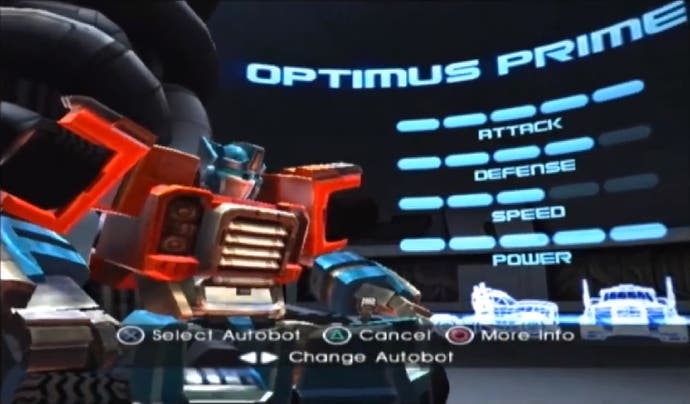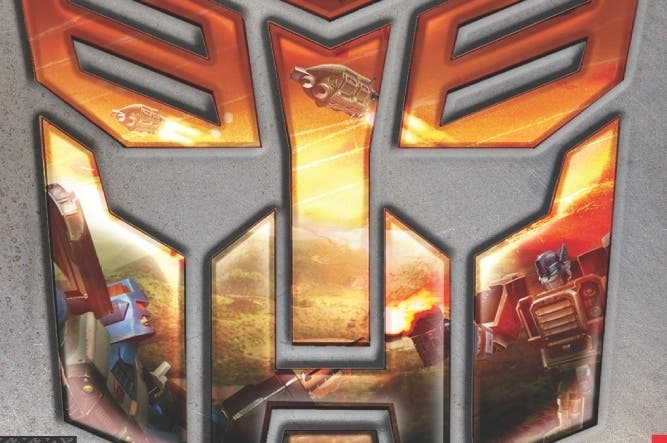Transformers retrospective
When Optimus was in his prime.
For better and for worse, Michael Bay's energetically stupid idea of the Transformers is now the most dominant version of the franchise in popular culture. I've seen all three of his swaggering, over-long movies and will most likely see the fourth instalment with Mark Wahlberg when it comes out this summer. But as someone old enough to just about remember the first generation of toys - boxy marvels that, through a complex sequence of manipulations, could become convincing muscle cars or fighter jets or cassette decks - I've found precious little to love in the maximal movie Cybertronians.
The absurdly detailed yet still practically interchangeable designs for these Autobots and Decepticons were presumably rubber-stamped by Bay in those rare moments when he wasn't rubbing his hands with glee over the pre-vis storyboard of another endless CGI sequence in which a major US city is obliterated. Also, while I'm grudgingly grateful he kept "the noise" - that distinctive, crunchy audio cue that suggests a symphony of servos rearranging metal in a hurry - all of Bay's Transformers films are just too darn loud.
For some peace and quiet, you have to travel back a decade to 2004, a time when the movies didn't exist and, admittedly, the Transformers brand was a little becalmed. But it was ten years ago that Atari released Transformers, developed by Melbourne House as an exclusive for PlayStation 2. No-one was expecting much from a game based on Transformers Armada, a short-lived and relatively minor cartoon reboot of the franchise, but in a ridiculously short development window - just a year, according to director and executive producer Andrew Carter - Melbourne House somehow transformed this unpromising licence into one of the most technically accomplished and downright enjoyable PS2 games of its generation.

Even for fanboys, though, the set-up is sheer hokum. During one of their regular smackdowns on Cybertron, Optimus Prime and Megatron are interrupted by a distress signal from the long-lost Mini-Cons. These diminutive Transformers, designed to enhance the offensive and defensive capabilities of their bigger brothers, abandoned Cybertron a million years ago and ended up crash-landing on Earth.
Realising the tactical importance of these dinky boosters, both factions of Transformers immediately roll out to recon our pale blue dot. The supposedly unparalleled military strategist Optimus enlists just two lieutenants for the mission - speedster Hot Shot and techno-sawbones Red Alert - while the wilier Megatron ferries down thousands of easily replicable Decepticlones, an endless supply of just-smart-enough cannon fodder to impede Prime's progress.
Perhaps the smartest design decision here was to create levels set in totally remote locations on Earth. Rather than stomping around New York, your selected Autobot beams down to search for Mini-Cons in places like the Amazon rainforest and a flinty atoll in the mid-Atlantic. By removing the need to render cities, humans or traffic, Melbourne House could focus all the PS2's processing power on creating starkly beautiful, isolated locales: Far Cry with a hint of Starscream.
"After ten long years, Melbourne House's effort remains the definitive Transformers game."
Transformers wasn't so much an open world game as an abandoned world game. The juxtaposition of a gigantic alien robot clambering over ancient Aztec temples was surprisingly poetic, and seemed more like an adaptation of an apocalyptic JG Ballard novel than a commercially-minded Japanese cartoon. It also felt oddly timeless. The only real hint that your mission to corral all the Mini-Cons was taking place in nominally contemporary times was when you made it to the Antarctic and ended up stomping all over a human-proportioned research station.
Though I treasured the unexpected stillness and moments of awe in the face of nature's grandeur, they were often shattered by fizzing laser-fire and the low whump of EMP grenades. Combat was unavoidable in Transformers, and while you could satisfyingly ram smaller Decepticlones while in vehicle mode, there were far more offensive options in robot form. Up to four Mini-Cons could be added to your loadout, their abilities mapped to the four shoulder buttons. From a sniper rifle to various flavours of smart missile, a cloaking device to mobility boosts, you were expected to experiment to find the most effective set-up for each situation.
The combat itself was rarely surgical, with your giant Autobot feeling a little ungainly and every defeated Decepticlone exploding in a distracting corona of sparks and precious collectible Energon. Each encounter was basically a crapshoot, but there was great satisfaction from either outsmarting your opponents or simply overwhelming them with superior firepower. The combination of turbulent third-person shooting and the pic'n'mix of weapons seemed to owe a debt to Ratchet & Clank, although with Red Alert replacing the previous Autobot medic Ratchet and much more of an emphasis on clanking.

The narrative was linear, in that you needed to eventually beat a brand-name, non-Decepticlone boss like Cylconus to proceed to the next frontier location, but you were free to revisit previous levels to soak up the atmosphere or simply drive around and explore, rejoicing in "the noise" each time you toggled from robot to vehicle. The locations opened up even more once you recovered Slipstream, the Mini-Con that granted you the ability to glide and therefore access parts of levels that were previously off-limits.
Though a lot of the charm of Transformers came from stringing together satisfying nuggets of emergent gameplay, one of the most memorable levels was essentially one long set-piece. In the biting wind and rain of the mid-Atlantic, you were tasked with infiltrating a gigantic Decepticon aircraft carrier. After battling your way through the belly of the beast and emerging with your prize, the gigantic craft took the hump and transformed into a end-of-level baddie of Godzilla-like proportions. Even Optimus, who was notably taller than the other two playable Autobots, seemed like little more than Mini-Con next to the towering Tidal Wave. It was an ambitious, witty and executed with a greater degree of cinematic flair than you-know-who.
With only eight levels, Transformers did become a bit of a slog towards the end, tasking you with attacking identical pre-fab bases and bunkers stuffed to the gills with Decepticlones. But just as it felt like Melbourne House had run out of steam, they staged a wildly ambitious final level where - spoiler! - you returned to Cybertron, strapped on an orbital jetpack and took on planet-sized baddie Unicron like he was the Death Star. It was a rousing climax.
With its evocative visuals and impressive 60fps frame-rate, Transformers received enthusiastic reviews but didn't achieve a huge amount of sales traction. A "director's cut" was released and re-promoted a few months after the original, although the only real addition seemed to be the inclusion of a making-of documentary on DVD. A planned PC version was scrapped.
After Bay re-energised the franchise in 2007, subsequent Transformers games trundled down a different path, with a predictably shonky tie-in to the first movie before developers High Moon Studios grabbed the wheel, creating and deepening their own intricate mythology that focused entirely on the Autobots and Decepticons duking it out on Cybertron.
The High Moon games, while polished, reasonably popular and - in the case of Fall Of Cybertron - quicker off the mark than Bay in realising the potential cult draw of Grimlock feel a little soulless to me. With no pressing need to even vaguely resemble Earth-based vehicles, the character designs are pure sci-fi. (They've also become their own toy line which in this context, must be the highest mark of success.)
Two new games are due this year, although the prospect of Transformers Universe, a free MMO that promises non-stop action, simply doesn't appeal. It's not fashionable, but I like my giant robots with a side order of lush jungle and tropical birdsong which is why, even after ten long years, Melbourne House's effort remains the definitive Transformers video game. In robot form, their Autobots actually vaguely resemble the vehicles they transform into, and that makes "the noise" sound all the sweeter.

